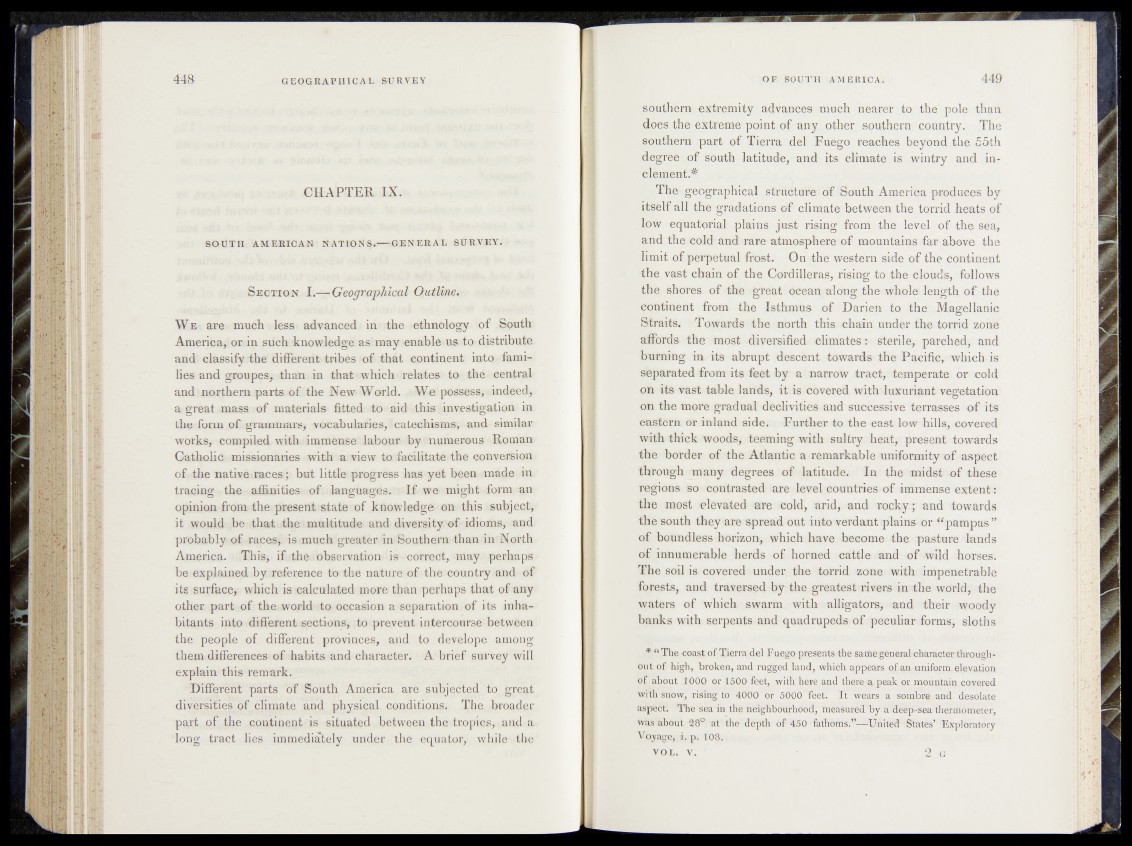
CHAPTER IX.
SOUTH AMERICAN N A T K) N S.— GENERAL SURVEY.
S e c t io n I .— Geographical Outline.*
We are much less advanced iiL the /ethnology H South
America*-or/in sueh knowledge asimay enable-us4c&distribute
and' classify the different tribes ’of that continent into- fami-
lies and grapes, than in that-/which/relates t e Ad/Central
and northern parts of the New World. 0Wepossess* s4ndpe%:
a great mass of materials fitted to aid tins (h^e^agadioA^ in
the form of grammars, vocabularies, f catechisms, and similar
works, compiled with immense labour by numerals Roman
Catholic missionaries with a view to-facilitate the conversion
of the native* races; but little* progress has yet been/made in
tracing - the affinities- of languages.r If we might form an
opinion from the present state of knowledge on this subject,-
it would be-that the? multitude and diversity W idioms, and
probably .of -races}- is^mucb greater in Southern than iruNorth
America. This* if .the-observation is-correct, may perhaps
be explained by reference to the nature of the country and of
its surface*- which is calculated more than perhaps that of any
other part of the,.world’ to occasion a separation of its inhabitants
into-different-sections, to prevent intercourse between
the people of different provinces, and to develope among
them*differences of habits and character. A brief survey will
explain this remark.
Different parts of South America are subjected to. great
diversities of climate and physical conditions. The broaden
part oC the continent is situated between the tropics, and a
flong tract lies immediately under the equator, while the
southerrn extremity advances much nearer to the pole than
does the extreme point of any other southern country. The
southern part of Tierra del Fuego reaches beyond the 55th
degree of south latitude, and its climate is wintry and inclement.*
.
The geographical structure’ of South America produces by
itself all the gradations o f climate between the torrid heats of
low equatorial plains just rising from the level of the sea,
and the oold and rare atmosphere of mountains far above the
limit of perpetual frost. On the western side of the continent
the vast chain of the Oordilleras, rising to the clouds, follows
the shores of the great ©eeanaloUg-the whole length of the
continent from the Isthmus of Darien to the Magellanic
Straits. Towards the north this uehain undër the torrid zone
affords the most diversified climates : sterile* parched, and
burning in its abrupt descent tirivards th® Pacific, which «
separated from its feet by a narrow tract, temperate or cold
on its vast table lands, i t is covered with luxuriant végetetion
on the more gradual declivities and successive terrasses of its
eastern or inland side. Further to the east low hills, covered
with thick woods, teeming with sultry heat, present towards
the border of the Atlantic a remarkable uniformity/of aspect
through /« an y degrees of latitude. In the/midst of these
régions so Contrasted -are level eountriestof immense extent :
the most elevated- are cold, arid, and rocky ^ and towards
the south they aro spread out into verdant plaim or^pampas’'
of boundless horizon, whieh have become the pasture lands
of innumerable herds of homed cattle and of-wild horses;
The sod is covered under the’ torrid zone with, impenetrable
forests, and traversed by the greatest rivers in the world, the
waters of which swarm with alligators, and their woody
banks with serpents and quadrupeds.of peculiar forms, sloths
*.“The coast of Tierra del Fu^epresents-the saaae general character throughout
of high, broken, and rugged land, which appears q . an. uniform^ elevation
of about 1000 Or 1500 feet, with here, and theref%;pfak. or mountain covered
witn show, rising to 40OO or 5-000 Tefet. It wears a sombré, and desolate
aspect. "The sea ih th'e néignbOTlhdâË, fcëasürédiiy a'Weép-Sea thermometer*
was about $8° at'the depth of 450 fathoms.”- i Uhitedl 'States’ Exploratory
¥ç$age*fop,
VOL. V. ■ - 2 Sjfi